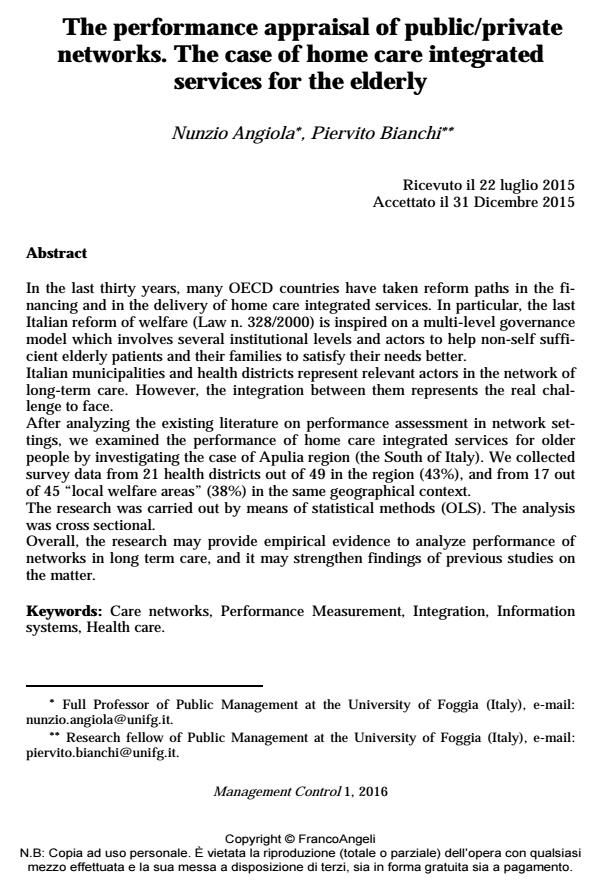The performance appraisal of public/private networks. The case of home care integrated services for the elderly
Journal title MANAGEMENT CONTROL
Author/s Nunzio Angiola, Piervito Bianchi
Publishing Year 2016 Issue 2016/1
Language English Pages 12 P. 59-70 File size 64 KB
DOI 10.3280/MACO2016-001004
DOI is like a bar code for intellectual property: to have more infomation
click here
Below, you can see the article first page
If you want to buy this article in PDF format, you can do it, following the instructions to buy download credits

FrancoAngeli is member of Publishers International Linking Association, Inc (PILA), a not-for-profit association which run the CrossRef service enabling links to and from online scholarly content.
In the last thirty years, many OECD countries have taken reform paths in the financing and in the delivery of home care integrated services. In particular, the last Italian reform of welfare (Law n. 328/2000) is inspired on a multi-level governance model which involves several institutional levels and actors to help non-self sufficient elderly patients and their families to satisfy their needs better. Italian municipalities and health districts represent relevant actors in the network of long-term care. However, the integration between them represents the real challenge to face. After analyzing the existing literature on performance assessment in network settings, we examined the performance of home care integrated services for older people by investigating the case of Apulia region (the South of Italy). We collected survey data from 21 health districts out of 49 in the region (43%), and from 17 out of 45 "local welfare areas" (38%) in the same geographical context. The research was carried out by means of statistical methods (OLS). The analysis was cross sectional. Overall, the research may provide empirical evidence to analyze performance of networks in long term care, and it may strengthen findings of previous studies on the matter.
Keywords: Care networks, Performance Measurement, Integration, Information systems, Health care.
- Agranoff R., McGuire M. (1999), Managing in network settings, Policy Studies Review, 16, pp. 18-41. DOI: 10.1111/j.1541-1338.1999.tb00839.x
- Belsely D.A., Kuh E., Welsch R.E. (1980), Regression Diagnostics: Identifying Influential Data and Sources of Collinearity, New York, Wiley.
- Borgonovi E. (2004), Ripensare le amministrazioni pubbliche. Tendenze evolutive e percorsi di approfondimento, Milano, Egea
- Boscolo P.R., Canobbio M, Ciani O. (2012), Hospital-based HTA: quale valore per la valutazione delle tecnologie nelle Aziende Sanitarie italiane?, Management Control, Suppl. 2, pp. 55-69. DOI: 10.3280/MACO2012-00SU2004
- Bouckaert G. (1993), Measurement and meaningful management, Public Productivity & Management Review, 17, pp. 31-43.
- Bouckaert G. and Halligan J. (2008), Managing Performance: International Comparisons, London, Routledge.
- Carmines E.G., Zellner R.A. (1979), Reliability and Validity Assessment, Newbury Park, CA, Sage Publications Inc.
- Castellano N. (2011), Modelli e misure di performance aziendale: analisi della letteratura e spunti di ricerca, Management Control, 1, pp. 41-63. DOI: 10.3280/MACO2011-001003
- Conrad D.A., Cave S.H., Lucas M., et al. (2003), Community Care Networks: Linking Vision to Outcomes for Community Health Improvements, Medical Care Research, 60, pp. 95-129.
- Cronbach L.J. (1951), Coefficient alpha and the internal structure of tests, Psychometrika, 3, pp. 297-334.
- Fox J. (1991), Regression Diagnostics, Newbury Park, CA, Sage Publications
- Herranz Jr. J. (2010), Multilevel Performance Indicators for Multisectoral Networks and Management, The American Review of Public Administration, 40, pp. 445-457. DOI: 10.1177/0275074009341662
- Hood C. (1991), A public management for all seasons, Public Administration, 69, pp. 3-19. DOI: 10.1111/j.1467-9299.1991.tb00779.x
- Kickert W.J.M., Klijn E., Koppenjan J.F.M. (1997), Managing Complex Networks: Strategies for the Public Sector, London, Sage
- Longo F. (2005), Governance dei network di pubblico interesse: strumenti operativi economico aziendali, Milano, Egea.
- Marchi L. (2011), Integrazione pubblico-privato su metodologie e strumenti di controllo gestionale, Management Control, 2, pp. 5-8. DOI: 10.3280/MACO2011-002001
- McGuire M., Agranoff R. (2011), The limitations of public management networks, Public Administration, 89, pp. 265-284. DOI: 10.1111/j.1467-9299.2011.01917.x
- Meneguzzo M., Cepiku D. (2008), Network pubblici. Strategia, struttura e governance, Milano, McGraw-Hill.
- Mitchell R.E., Florin P. and Stevenson P.E. (2002), Supporting Community-Based Prevention and Health Promotion Initiatives: Developing Effective Technical Assistance Systems, Health Education and Behavior, 29, 620-39.
- Nunnally J. C. (1978), Psychometric theory (2nd ed.), New York, McGraw-Hill.
- O’Toole L.J. (1997), Treating Networks Seriously: Practical and Research-Based Agendas in Public Administration, Public Administration Review, 1, pp. 45-52. DOI: 10.2307/976691
- O’Toole L.J. Jr., Meier K.J. (2004), Desperately Seeking Selznick: Cooptation and the Dark Side of Public Management in Networks, Public Administration Review, 64, pp. 681-93. DOI: 10.1111/j.1540-6210.2004.00415.x
- Provan K.G., Milward H.B. (1995), A Preliminary Theory of Interorganizational Network Effectiveness: A Comparative Study of four Community Mental Health Systems, Administrative Science Quarterly, 40, pp. 1-33.
- Provan K.G., Milward B.H. (2001), Do Network Really Work? A Framework for Evaluating Public Sector Organizational Networks, Public Administration Review, 61, pp. 414-23.
- Rhodes R.A.W. (1996), The New Governance: Governing without Government, Political Studies.
- Turrini A., Cristofoli D., Frosini F., Nasi G. (2010), Networking literature about determinants of network effectiveness, Public Administration, 88, pp. 528-550. DOI: 10.1111/j.1467-9299.2009.01791.x
- Voets J., Van Dooren W., De Rynck F. (2008), A framework for assessing the performance of policy networks, Public Management Review, 10, pp. 773-790.
- La Network Governance a supporto dell'Open Innovation: un'analisi della letteratura Palmira Piedepalumbo, Concetta Metallo, Daniela Mancini, in MANAGEMENT CONTROL 3/2017 pp.79
DOI: 10.3280/MACO2017-003006
Nunzio Angiola, Piervito Bianchi, The performance appraisal of public/private networks. The case of home care integrated services for the elderly in "MANAGEMENT CONTROL" 1/2016, pp 59-70, DOI: 10.3280/MACO2016-001004